What is SEO-The Complete Guide to Reach Top Google Results
SEO is a key Digital Marketing strategy.
After all, who wouldn’t want to show up within the top organic search results on Google?
It’s where users find the most visible links, as well as those most frequently accessed by users — who generally don’t go past the first page of results to find what they’re looking for.
And having a good SEO strategy can get you there!
Your site, blog, or eCommerce become more well-known, resulting in authority in the market, a greater number of visitors, and increased conversion opportunities.
Best of all? You can achieve all of this without having to invest in paid advertising.
Through optimizations on your own pages and connecting to other sites, you can improve your users’ search and navigation experience.
What is SEO?
SEO, or Search Engine Optimization, is a set of optimization strategies for sites, blogs, and pages on the web, which aim to improve your position in organic search engine results.
Every second, millions of searches are being processed by search engines — principally Google, the most popular search engine worldwide.
Users are looking for answers to an incredible range of questions from their daily routine (from the best-rated hotel for an upcoming trip to an explanation of the theory of evolution).
For every search, Google organizes the results by ranking the best answers first. The numbers below show just how much users trust the judgment of search engines:
- The first three organic links receive approximately 30% of all click-throughs.
- Only 0.78% of users access a link on the second page of results.
Take a look at the graph below to see the correlation between position ranking and the number of clicks:
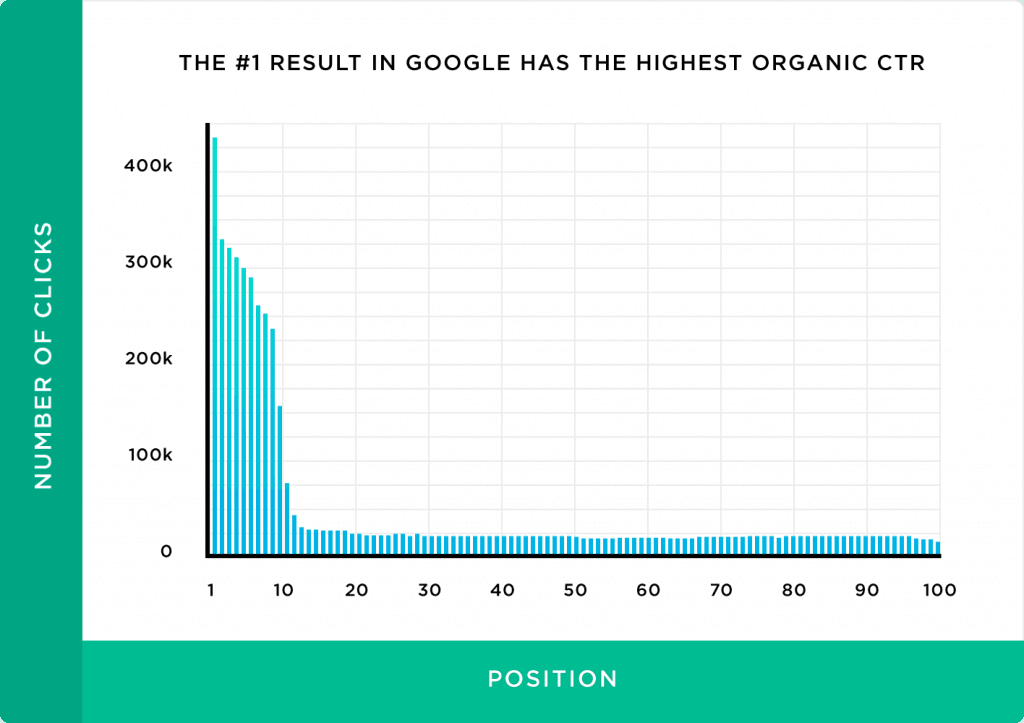
Source: Backlinko
Every search presents the opportunity for your brand to offer the best response to what users are looking for.
With this as your focus, you have a better chance to increase your visibility and clicks, receive more organic traffic, and escalate results with your online presence.
But, to achieve this, you need to prove to Google that you have the best answer and deserve to show up in the first position on the SERP (Search Engine Results Page).
This involves not just having great content, but offering usability, communicating marketplace authority, and helping Google read your pages.
These are the goals of an SEO strategy.
SEO also plays a role in SEM (Search Engine Marketing), which covers all search engine strategies, including paid ads and sponsored links
On the other hand, SEO only makes use of organic strategies and doesn’t encompass media purchases. This results in a higher return over investment (ROI) and lower customer acquisition cost (CAC).
What are Search Engines?
Search engines are systems or algorithms to crawl, index, and rank web content to display it in an ordered way based on user searches.
When we refer to search engines, we’re not just talking about Google, but also Bing, Yahoo!, Baidu and others.
Even YouTube and Pinterest can be thought of as search engines since they’re often used to discover content.
But Google is the clear category leader, with almost 92% of the search market share.
Each search engine has its own methodology and ranking criteria. But the end goal is always the same: offering the best results to what users are looking for.
How do Search Engines Work?
Have you ever considered exactly what Google does when you search for something? Despite only taking milliseconds, there’s a long process to be able to display a list of results that answer your question.
In general, search engines have three stages:
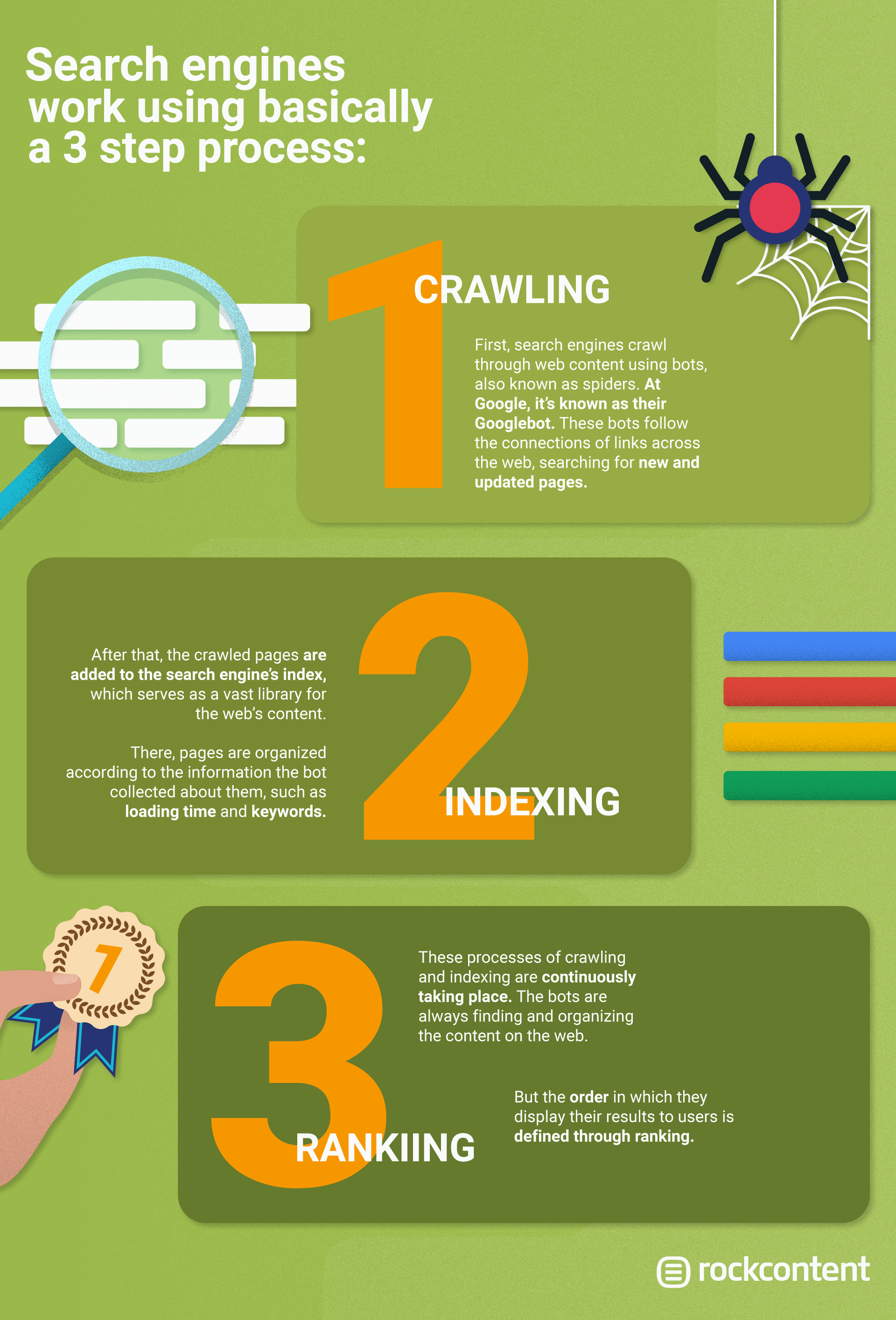
First, search engines crawl through web content using bots, also known as spiders. At Google, it’s known as their Googlebot. These bots follow the connections of links across the web, searching for new and updated pages.
After that, the crawled pages are added to the search engine’s index, which serves as a vast library for the web’s content.
There, pages are organized according to the information the bot collected about them, such as loading time and keywords.
These processes of crawling and indexing are continuously taking place.
The bots are always finding and organizing the content on the web. But the order in which they display their results to users is defined through ranking.
Ranking occurs every time a user searches something — this is the focus of SEO.
According to the keywords used in the search, Google quickly goes through its index to find pages that coincide with those terms and respond to the question.
Thus, classification is determined by the best relationship between keywords and a series of ranking factors that make up the search algorithm.
They serve to offer better user experience and, as a result, increase your page’s position in the search results.
We will focus on these factors in detail below.
Google’s Algorithm and Updates
Google’s algorithm is the combination of operations that define how links are classified on the organic search results page. Its function is to create a hierarchy of pages to provide results in the most relevant order for each user.
The algorithm adopts a series of criteria to achieve this and is continuously updated to become more and more relevant.
Through these updates, Google aims not just to improve the classification of results but also to eliminate or decrease the position of malicious and low-quality content, which can harm the user experience.
Thousands of updates occur every year, but several stand out for their impact on the SEO market. These were the key updates to Google’s algorithm in recent years:
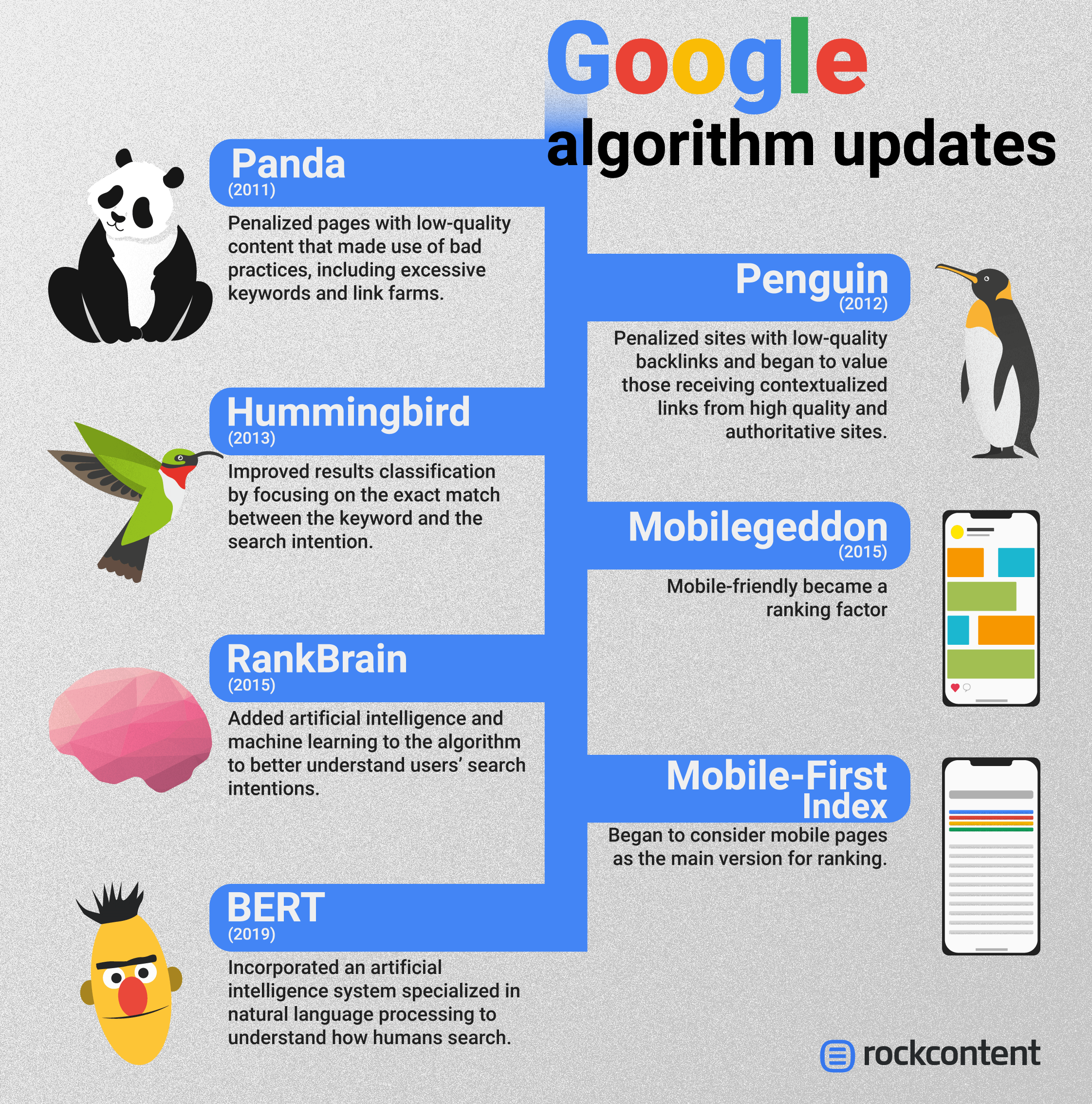
- Panda (2011): penalized pages with low-quality content that made use of bad practices, including excessive keywords and link farms.
- Penguin (2012): penalized sites with low-quality backlinks and began to value those receiving contextualized links from high quality and authoritative sites.
- Hummingbird (2013): improved results classification by focusing on the exact match between the keyword and the search intention.
- Mobilegeddon (2015): mobile-friendly became a ranking factor.
- RankBrain (2015): added artificial intelligence and machine learning to the algorithm to better understand users’ search intentions.
- Mobile-First Index: began to consider mobile pages as the main version for ranking.
- BERT (2019): incorporated an artificial intelligence system specialized in natural language processing to understand how humans search.
Ranking Factors
It’s estimated that Google’s algorithm involves more than 200 ranking factors. The relationship between them determines the position on SERPs.
Google doesn’t publically share these factors but has made some statements which reveal some secrets. Moreover, the market itself performs studies to determine the impact of specific actions on-page ranking.
In general, we know that there are two types of ranking factors: on-page and off-page.
On-page
On-page ranking factors are located on their own pages. When on-page SEO gets mentioned, it’s referring to the optimization of these elements.
Some examples:
- Content
- Title and meta description
- Heading tag
- Images
- URLs
- Rich snippets
Google evaluates these factors to understand what information the pages bring and, therefore, how to index them correctly.
In addition, the search engine analyses if the page is offering a good user experience with relevant information.
Off-page
Off-page factors, on the other hand, are elements that demonstrate the page’s status as a reference but are not located in the content of the page.
Off-page SEO consists of optimizing the site’s authority to users and other websites, with a focus on acquiring backlinks.
Some examples of these factors are:
- Number of backlinks
- Diversity of backlinks
- Context of backlinks
- Brand mentions
- Social signs
- Direct search
For Google, factors along these lines reveal a site’s level of authority.
If a page receives many visitors via direct searches for a brand name and many backlinks or mentions from trusted sites, it’s considered more authoritative in the market.
Black Hat vs White Hat
Google’s algorithm is always improving the search experience for users.
This means not just continually improving search results, but also combating dubious and low-quality content, known as Black Hat SEO.
Black Hat has been a target of Google since the early days of SEO.
When the algorithm was still new and had a lot of loopholes, it was easy to game the system to get a higher ranking, even if you had nothing to offer.
Common Black Hat strategies included:
- Doorway pages: pages optimized to redirect users to malicious pages
- Cloaking: pages which present different content to real users and bots
- Link farms: pages that only contain backlinks to other pages
- Keyword stuffing: pages excessively repeating keywords
- Hidden texts and links: pages hiding text and links from the user, but not from bots
- Comment spam: pages that comment on blogs to gain backlinks
In the example below, you can see code configured to hide keywords by using text set to a font size of 0 and the same color as the background:
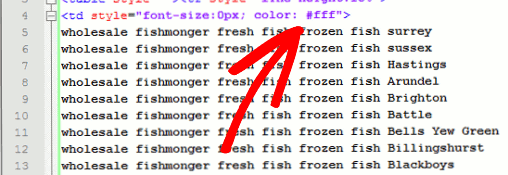
Source: OptinMonster
Strategies like these still exist. However, Google’s algorithm is increasingly complex and more intelligent at identifying Black Hat SEO.
For example, a massive increase in backlinks from suspicious domains over a short period of time is an indication of Black Hat techniques.
When this happens, pages are penalized, which can range from a temporary drop to a complete ban.
So, avoid Black Hat SEO.
If you want to earn trust from search engines to guarantee a safe and sustainable position on SERPs, follow Google’s SEO guidelines.
These guidelines coincide with White Hat SEO, acceptable SEO strategies recommended by search engines.
These can include, for example, improving site usability, natural use of keywords in the content, receiving backlinks from trustworthy partners, among other strategies we will introduce in this guide.
Why is SEO Important?
These days, the average Google search is about a lot more than just finding facts and quick answers on the fly.
Search engines are where people turn for all sorts of information — everything from Billy Joel song lyrics, to relationship advice, to directions to the nearest Chinese takeout place.
In other words, the reasons behind search engine users’ collective queries are varied and complex. Google and the rest of the search engines are evolving exponentially to stay in step with this reality. And the more this becomes the case, the more important SEO also becomes.
Without SEO, it ultimately won’t matter how well your website answers a searcher’s questions or how beneficial your products might be to a consumer looking to buy.
If the search engines don’t crawl, index, and rank your website, no one will ever find it.
That said, a strong, comprehensive SEO strategy:
- Helps you achieve the high SERP rankings needed to earn clicks and drive traffic.
- Boosts your credibility — something that always accompanies a high ranking.
- Gives you an edge over your competitors.
- Expands your market reach and builds your audience.
- Boosts your overall engagement rates.
- Improves the overall user experience on your website or eCommerce shop.
- Gets locals through your doors if you run a brick-and-mortar business.
Ultimately, SEO is the key to getting you seen, attracting the audience you’re trying to reach, and making a success out of your business.
The sooner you master the basics of solid optimization, and the more you understand about how changes to your site affect SEO, the more successful you can expect to become.
It’s also crucial to understand that as search engine algorithms and consumer expectations change, so do the go-to best SEO practices to know.
That means SEO isn’t just something you master once. It’s something you continue to learn about and grow with indefinitely.
[
How to Start an SEO Strategy?
To achieve the organic traffic you’re looking for, the content published on your blog must be relevant to someone. You already know that, but how do people find your content?
Like any marketing strategy, it all starts with planning: what are the results you hope to achieve through SEO, who are you trying to reach, and how do you intend to get there?
This will pave the way to your strategy’s success.
Also, you should know that an SEO strategy generally delivers results in the medium to long term.
Don’t expect the kind of immediate return which can come from ads and sponsored links. However, SEO usually achieves a more sustainable return in the long term.
With that in mind, let’s take a look at the first steps of SEO.
1. Define objectives
The first step in creating your strategy is to define your objectives in optimizing your site, blog, or eCommerce. To do this, you first have to know what SEO offers.
- Increase organic traffic
- Generate more leads
- Create more sales
- Reduce client acquisition cost (CAC)
- Educate the market
- Increase brand authority
Always seek to align these SEO objectives to your brand’s macro-objectives. If your goal is to increase brand awareness, for example, SEO can help with this by placing your company’s site among the first positions on Google.
By setting objectives, you can also identify goals and KPIs.
If you’re looking for greater authority, for example, you can use metrics from Domain Authority and Page Authority. Set the goals you hope to reach via these KPIs and when.
By doing so, while you execute your strategy and afterward, you can check these indicators to know if you’re on the right path to achieve your objective.
2. Define your buyer persona
Another important planning step is to define your buyer persona.
After all, who is your strategy for? Who are you communicating with? Who are you bringing to your business?
A buyer persona is the description of a semi-fictitious personality who represents an ideal customer for your brand, with real questions, pains, and needs, which you can help to solve.
They should be based on real customer data obtained through surveys, questionnaires, and interviews.
Building your buyer personas should take into consideration the different demands a customer may have throughout the stages of the funnel.
This can be observed in the keywords used to search: more general at the top of the funnel, and more specific towards the bottom.
You’ll soon have a better idea of making the most of keywords.
[
3. Use the best SEO tools
To start with an SEO strategy, you need to know the basic tools.
They help to diagnose where you’re starting from, base your planning on, make initial optimizations, and begin to track the impact of each action.
For the most part, we’re talking about two indispensable SEO tools: Google Analytics and Google Search Console.
Google offers both for free, and they will play a huge role in measuring your strategy. Let’s get to know them better!
Google Analytics
Google Analytics is a widely-used data analysis tool that provides a vast array of resources to evaluate the performance of digital strategies.
For SEO, it can assist in a variety of ways:
- Understand your audience better to build your buyer persona.
- Identify your most visited and best-performing pages.
- Monitor organic traffic numbers.
- Identify which channels generate the most traffic (email, social, organic, etc.).
- Understand engagement (rejection rate, pages per visit, session length).
- Monitor conversions generated through the SEO strategy.
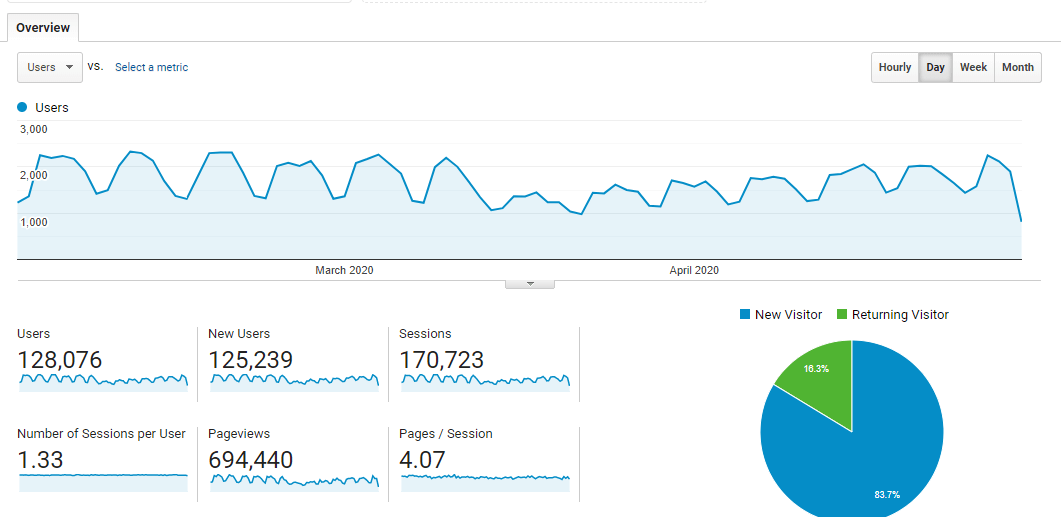
This is only a sample of the analysis available with Google Analytics, covering from the planning stages to the implementation of SEO.
But you find much more data in the tool to help with your strategy.
Google Search Console
Google Search Console is a tool to facilitate communication between the site and Google, which offers valuable SEO reporting. Some of the resources include:
- Discover if there are any issues on indexing your site.
- Know if your site has been hacked or penalized by Google.
- Monitor the average position of your pages on SERPs.
- Identify the organic click-through-rate of your pages on SERPs.
- Identify which keywords place your site on SERPs.
- Identify which sites backlink to yours.
- Solicit rejection of dubious backlinks to your site from Google.
Google Search Console is a little more technical, with a greater focus on webmasters.
But the interface is user-friendly, so anyone can use it to diagnose and direct more complex demand to specialized professionals.
This tool can also generate insights to optimize your content, in addition to being the principal source for identifying which searches bring traffic to your pages and the click-through-rate on your main keywords.

Source: ExpanderDigital
How to do a Keyword Research?
A keyword research aims to identify the search terms that have the greatest potential for your strategy, according to search volume, conversion, and competitiveness.
It’s one of the key planning tools for SEO strategy and Content Marketing. After all, it’s how you can identify optimization opportunities and set content creation priorities.
A keyword search usually starts with a list of terms related to your sector, product, and brand.
You can get ideas from Google Analytics and Google Search Console, which we previously discussed, or keyword tools, which we’ll learn more about below.
Afterward, this list needs to be organized. You can separate the most used terms at each stage of the sales funnel and sort the list based on the greatest potential for your strategy.
Let’s say you’ve just launched a blog on your site and have identified the keyword that will direct the most traffic to it.
You can start with it and create a post optimized for this keyword to attract more visitors.
Next, you’ll understand better what keywords are and what kind of terms you can work with.
What are keywords?
Keywords are how the users express their questions. They activate indexed pages in the search engine.
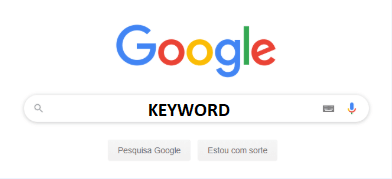
When a user searches for a specific term, Google looks for the best matches within its page index and displays these search results.
The order in which they appear is the result of ranking factors, as described above.
Therefore, keywords are essential in SEO strategies, as they reveal what our buyer persona is searching for.
They define the purpose behind optimizing a page, so Google indexes it correctly according to its content, presents it to the users seeking that topic, and ensures that the content is relevant.
It’s important to know that Google employs artificial intelligence to understand the intention of a search, the way humans communicate, and the variations that exist for a given term.
This means that if you want to optimize a blog entry for “carry-on luggage”, for example, you don’t need to worry about using this exact phrase in your text, much less repeat it endlessly.
You can use synonyms, such as “cabin baggage” or “hand luggage”, resulting in a more varied and engaging text.
So, even if the user types the term incorrectly or a variation of it, Google will understand the user’s search intention and display your page to them.
Thus, you don’t need to worry about a keyword’s exact match.
Types of Searches
During the purchase process, people may use different types of searches to resolve their questions.
To create your SEO and content strategies, you need to understand the intention behind each search to align what users are looking for with what your brand can bring them.
Let’s take a look at the main types of searches.
Navigational
Navigational search queries are when a user already knows which site they’re looking for and will rarely change their ultimate destination.
It’s as if they use Google as a shortcut, instead of remembering a whole URL or to find suggestions related to that site.
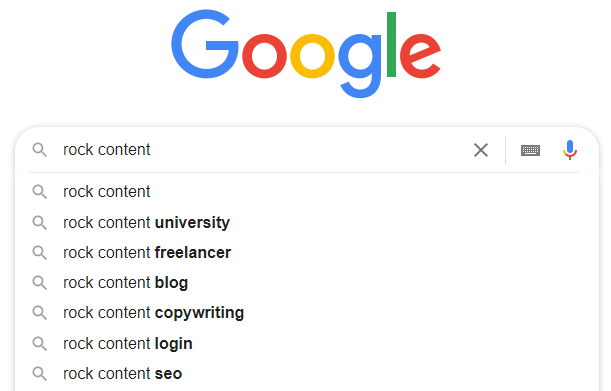
Transactional
Transactional search queries are related to purchases. For example, users may be looking to buy a product, find a store’s address, or compare prices.
This type of search is valuable because it can lead directly to a sale, as the user is already at a more advanced stage of the process.
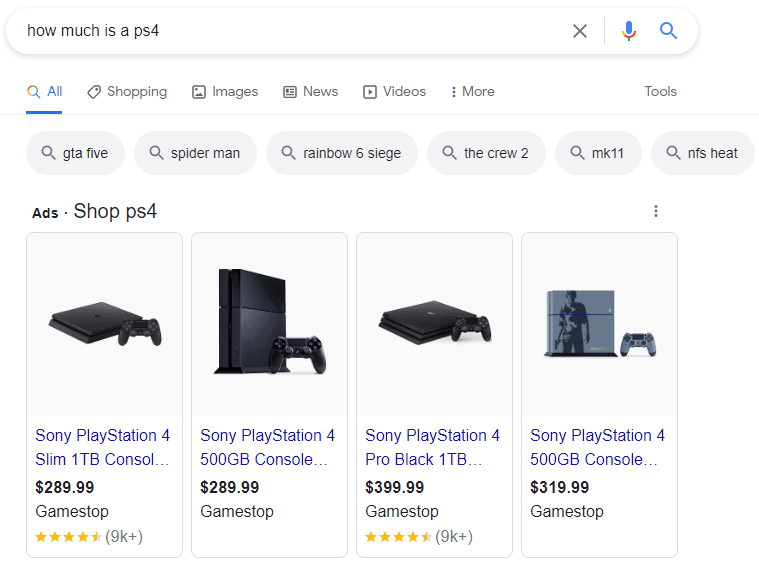
Informational
Informational search queries are when users are looking for information on a subject, product, or brand.
At this point, they don’t know what they want yet, as they’re at the start of the purchase process.
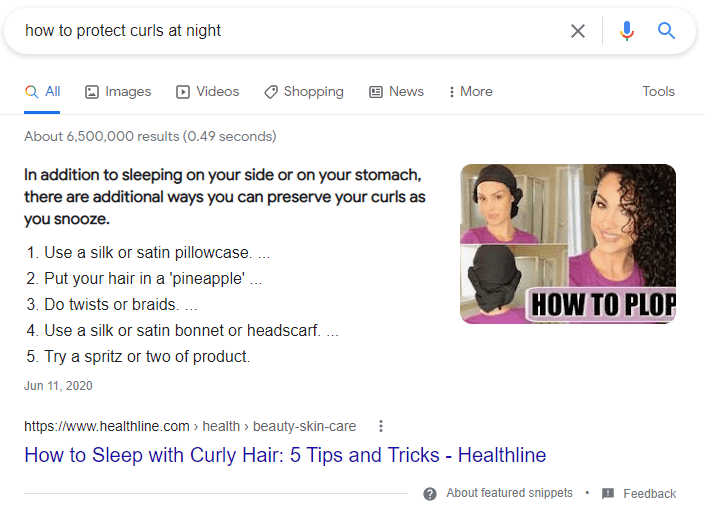
Local
Local search queries feature a geographic component, within a determined region.
These can include, for example, users searching for restaurants, cinemas, stores, hotels, schools, or offices, among other establishments with a physical location.
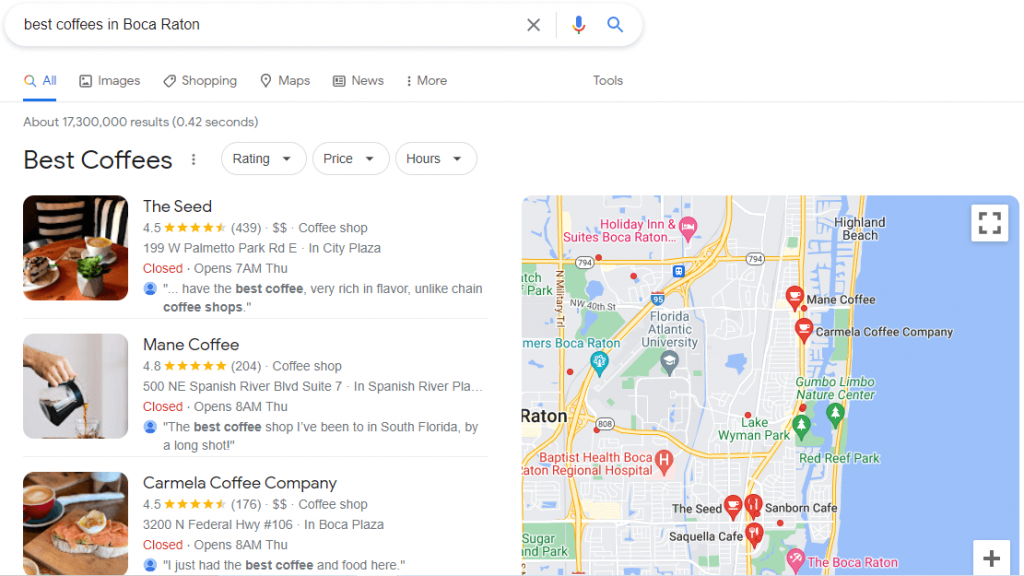
Other types of search
There are additional types of search a user may perform, such as:
- News
- Institutional
- Music
- Academic
- Punctual information (weather, date, etc.)
- Images
- Videos
Notice that, for each type of search, Google is constantly seeking to provide more specific results.
For product searches (transactional), you receive offers from Google Shopping. When looking for a certain song, results include the lyrics and a music video on YouTube.
The goal is to improve the search experience with more agile and precise results for users.
Types of Keywords
Along with types of search, we also need to consider the types of keywords that are used to find results on the web.
There are two types of keywords: head tail and long tail.
They refer to the two extremes you can see in the image below and correspond to different stages of the process.
The farther to the right the keyword lies, the more specific it is from a user closer to the purchase decision.
For an SEO strategy, it’s important to work with both types of keywords to reach potential clients at all stages of the process.


We will now look at each type.
Head Tail
Head tail keywords are broad, generic, and generally used at the start of the purchase process.
At this moment, the consumer doesn’t know what they need yet, and thus start with this type of search, before becoming more specific.
Generally, head-tail terms are high volume, resulting in a lot of traffic, but also attract a very wide audience with few conversion opportunities.
They also tend to face a lot of competition for the top search positions, making a high ranking more difficult.
In this case, examples include:
- Marketing
- Personal marketing
- Digital Marketing
- Business marketing
- Traditional marketing
Long Tail
Long-tail keywords are more specific and are usually used at the end of the process.
The customer has already researched what they need to meet their needs, is familiar with the solutions on offer, but still seeks information before making the final decision.
In contrast to the head-tail, long-tail keywords don’t usually generate as much traffic as they are less searched for.
On the other hand, they tend to attract visitors further along in the purchase process, as well as more conversions.
In addition, as a result of less competition, a higher ranking is easier to achieve.
If a user is interested in Digital Marketing, for example, they may now search for more specific terms on the topic. The specificity of terms will depend on the need the person needs to resolve, for example:
- Digital Marketing consultancy prices
- Where to take a Digital Marketing course
- The average salary for Digital Marketing professionals
Keyword Tools
Are you looking for help to find terms and identify the best opportunities? This is where keyword tools come in.
They are essential for planning an SEO strategy, as they help to find ideas for keywords, understand the potential and competitiveness of each, and organize them according to their optimization priority.
There are several tools for this, both paid and free.
Free tools help to perform specific search actions, including:
- Google Ads keyword planner: to check search volume and cost per click.
- Keyword Tool and Ubersuggest: to create lists of keyword ideas.
- Google Search Console: to check which words are already used to direct traffic to sites and opportunities.
- Google Trends: to determine search trends by theme.
Google Ads keywords planner is shown in the image below:
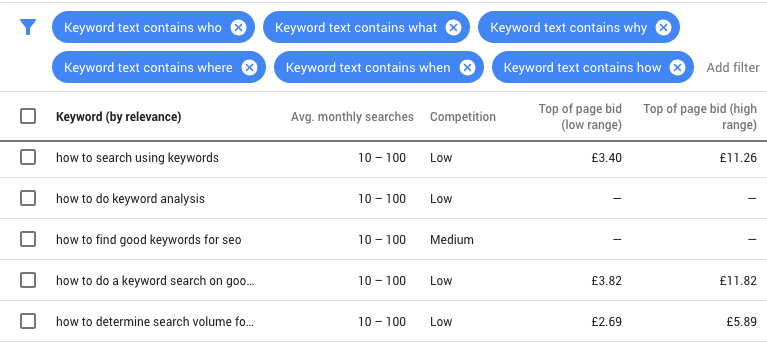
Source: Ahrefs
Paid tools are complete, with powerful keyword search features.
They suggest terms based on volume, clicks, difficulty to rank, and other data. The main platforms are:
- SEMrush (starting at US$99.95/month).
- Ahrefs (starting at US$99/month).
- Moz Keyword Explorer (starting at US$ 99/month).
Here’s an example of a keyword search on SEMrush:
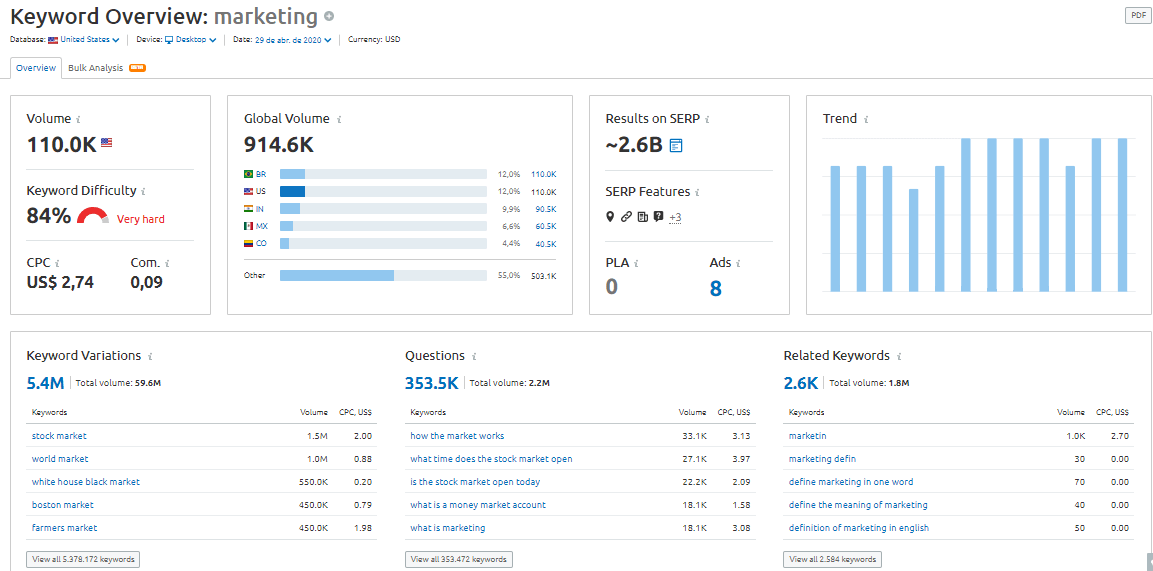
You can access some of the resources for free, but a paid plan allows you to take full advantage of the platform.
What is On-page SEO?
In this section, we will explore the key optimization factors for an on-page SEO strategy.
It’s worth remembering that “on-page” refers to the factors that an administrator can optimize on their own pages to improve a visitor’s experience and make it easier for Google to read the site.
These optimizations should be integrated within an overall Content Marketing strategy since they largely make use of what’s published on the blog.
Get a sense of the key on-page SEO factors.
User Intent
SEO is not about what people are searching, but what they want to find.
To do this, on-page optimization should focus on the user’s search intention, which varies from search to search, so your pages and content correspond to what they hope to find.
This is where Google’s focus on giving users what they’re looking for comes into play. For example, natural language processing and analyzing user location are elements that help determine their intention.
So, the challenge for an on-page SEO and Content Market strategy is understanding the search intention the way Google does, to deliver to users what they’re looking for.
And the best way to understand a user’s intention is by using Google itself!
Let’s take a closer look at some example.
Following your keyword search, you should use Google to analyze the highest-ranking results. After all, these are the pages that Google considers the best answer to the user’s intention.
Let’s examine the results page when we search for “SEO”:
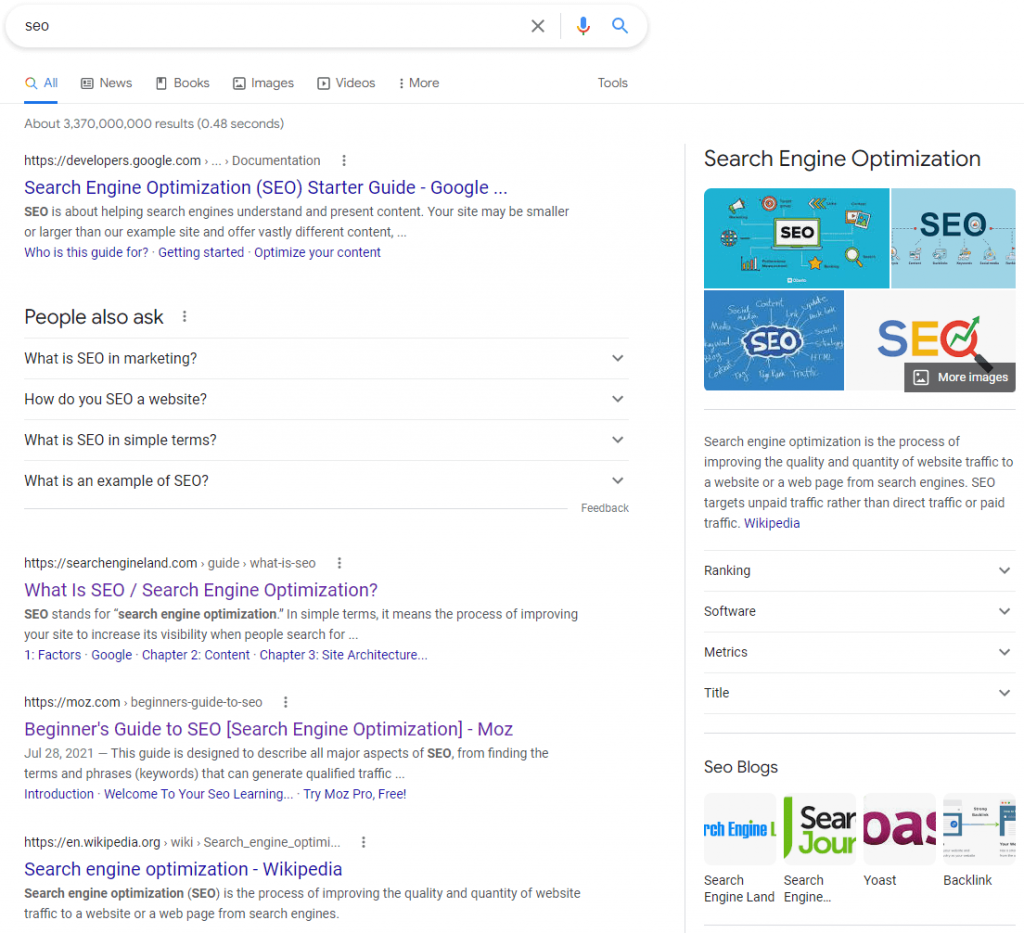
Note that the top results are educational, with a focus on teaching what SEO is and how to use it. To rank higher, you need to have content along these lines.
But what if my intention were to find a “Batman costume”? What am I trying to find?
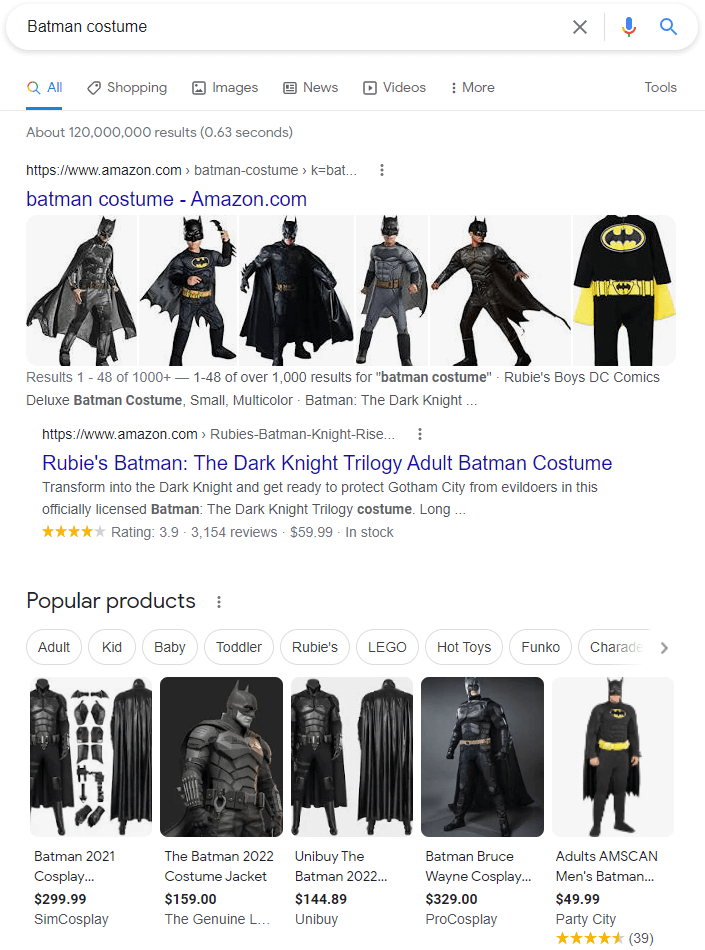
Pictures, exactly! Products and images. Can you imagine someone renting or buying a costume without seeing it first?
So, to reach the top of this result, you must use images.
Always use the first results for a specific keyword to identify how you should approach the subject and what else you can add to it.
Get ahead of them with content that’s even more optimized and complete!
Content length
The length of content generally affects its ranking, but it’s not a direct ranking factor in the algorithm.
Longer pieces tend to be complete, have more details, and go deeper into the subject matter. As a result, they better answer users’ questions.
But this isn’t necessarily a rule. For a given topic or buyer persona, the ideal length will be different.
Here at Rock, for example, we post super in-depth content, like this article.
It’s a broad search term, facing a lot of competition and receiving a high volume of searches, which demands extremely thorough content as a result.
On the other hand, a blog post about blocked actions on Instagram is far more specific, with fewer hits and competitors, so it can be shorter and more direct.
Accordingly, the best length is the one that best answers the user’s question.
Volume of posts
Publishing quantity also tends to favor classification, as the more content you publish, the greater chance you have to rank high.
However, you can’t just focus on the number of posts, ok?
Make sure you have a balance between quality and frequency.
There’s no point in publishing hundreds of pieces that aren’t relevant and don’t solve users’ questions — in fact, it’s counterproductive.
Likewise, having a large number of posts when you launch your blog, and then not keeping it updated brings no advantages.
Content creation needs to be an ongoing process in order to attract a loyal audience and show Google that what you have to offer is fresh and relevant.
Along the same lines as the volume of posts, there’s not an ideal frequency. You have to identify what your topic and buyer persona demand, as well as evaluating your business’s ability to produce this content.
The most important thing to remember is that quantity and quality work together.
Writing for SEO
How do you need to approach writing your content?
Quality is the number one priority. The content needs to be accurate, clear, current, relevant, trustworthy, and, of course, address the user’s intention.
This will generate engagement and increase the likelihood of receiving backlinks — weighty factors in the ranking calculation.
So even though Google increasingly understands and values natural writing, there are some strategies to optimize your content to reach higher positions, while also improving the reader’s experience.
To achieve this, it’s crucial to pay attention to an article’s scannability and semantics.
Scannability
Scannability is how a text presents a dynamic reading by making use of resources such as subtitles, lists, bold, and images.
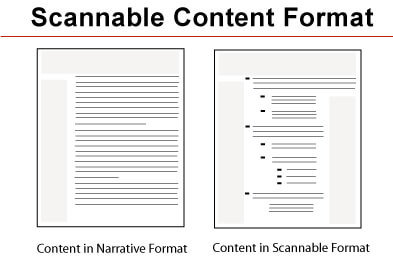
Source: Succesful Web
Have you ever opened an article, been faced with a solid block of text, completely lost your desire to read that content, and simply closed the page?
This is what makes scanability so important.
It improves the reading experience, engages the user, and even communicates information to Google.
By creating subtitles, for example, both readers and bots are able to understand the structure of the piece.
Keyword use and semantics
The use of keywords throughout your writing is important for Google to index the page with the terms you want correctly.
Keep in mind that this doesn’t mean just repeating one word the whole time, ok?
Google understands how humans use language and aren’t looking for exact keyword matches.
This is what makes semantics so important for SEO.
Take full advantage of a term’s semantic field, its variations, synonyms, and relationship with other words. By doing so, it becomes easier to read and helps Google to understand the topic of your page.
Let’s compare two pieces that have the objective to reach the first results for “Digital Marketing”:
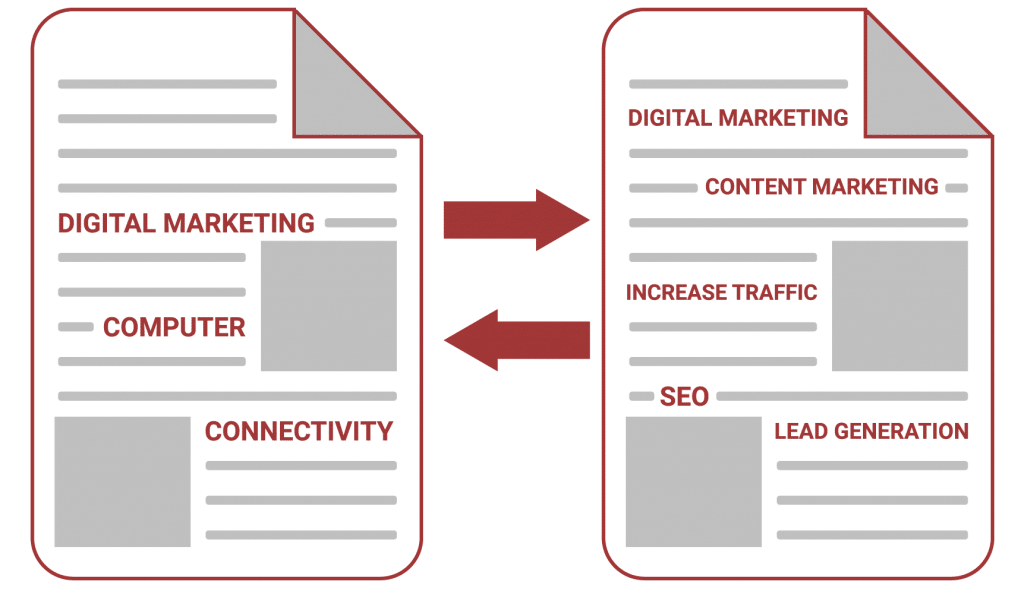
The content on the right has a better chance of a high ranking, as it covers indispensable topics directly related to producing a Digital Marketing guide.
Here’s another example focused on “SEO”:
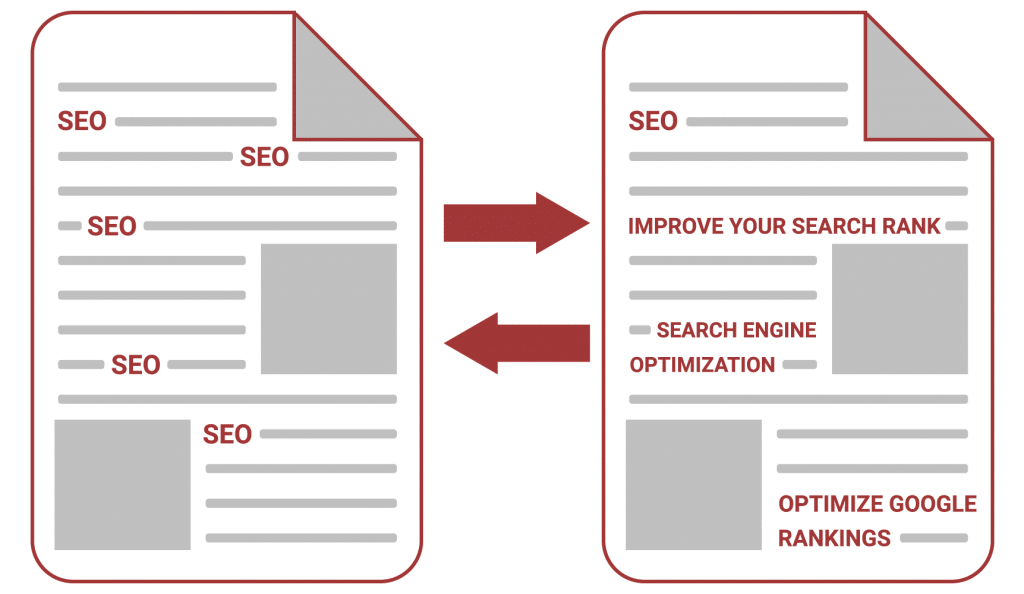
Again, the piece on the right displays better optimization, with several natural variations of the term, improving the reading experience for users and bots and increasing its chances of a higher position.
Furthermore, it’s important to place these terms where Google will value them the most.
The title, heading tags, URL, and the first paragraph are some examples of where bots tend to focus first.
So make sure to place keywords in these locations.
Title tag
The title of the page that you see on the SERP, in browser tabs, and when you share links on social networks is the Title Tag.

Title tags are fundamental for Googlebot to grasp the key theme of the page, and also for users.
After all, the title is the first contact a reader has with the text and can affect whether they click through to read it or not. With this direct influence on your click-through-rate, this tag is one of the most important on-page factors.
Therefore, as part of your SEO strategy, this tag should feature your keyword, but also incentivize your user to access your page.
Meta description
Meta descriptions are the description of a page that appears in search engine results, a snippet of the page with the title and URL.

They also serve as a way to encourage users to access the page, so they should be persuasive and descriptive about what is offered.
Note that meta descriptions are not a direct ranking factor, meaning Google doesn’t consider them in its algorithm.
But it’s still important to ensure your keyword shows up in it, as it will appear in bold if it coincides with what the user searched for.
Meta descriptions attract more clicks, indirectly influencing your results.
Heading Tags
Heading tags are code markup, which identifies titles and subtitles in the text.
The H1 tag identifies the title on the page, yet differs from the Title Tag.
If the goal of the Title Tag is to get users to click through, H1 aims to get users to read the text. It also doesn’t have the character limit of a Title Tag.
Take a look at this example:

Title Tag

H1
There is a structured order to heading tags, with H2, H3, and so on.
These heading tags identify subtitles and show the structure of your text, useful both for Google and for your user.
Using these increases scanability.
It’s important to use keywords, and semantically-related terms within these tags since Google analyzes subtitles for its indexing and ranking.
URLs for SEO
URLs are also targets for Googlebot.
Page URLs are crawled to get a sense of their central focus since they generally use terms that summarize their content.
They need to be clear to users and readers. Check out this table we made with some of the most common URL mistakes:

A descriptive URL is much easier to understand — not only for bots but also for users.
Here are some good practices:
- Easy to interpret
- Short and friendly
- Contain the keyword
- Match the title
- Avoid articles, linking verbs, and other complements
Some examples of good URLs:
- “sitename/blog/digital-marketing/“
- ” sitename/storytelling/”
- ” sitename/courses”
Images for SEO
Google still can’t completely understand the content of an image and needs your help to understand what it represents. What can you do?
Use image optimization for SEO.
This strategy allows you to provide textual data about the images. This can include alternative text (alt tag), filenames, image captions, image URLs, and context (the text around the image).
The important component here is the alt text, which is fundamental to the experience for individuals with visual impairments, as a screen reader reads the alternative text to describe the image to the user.
The alt text should always be a description of the image and contain the keyword.
Consider this example:
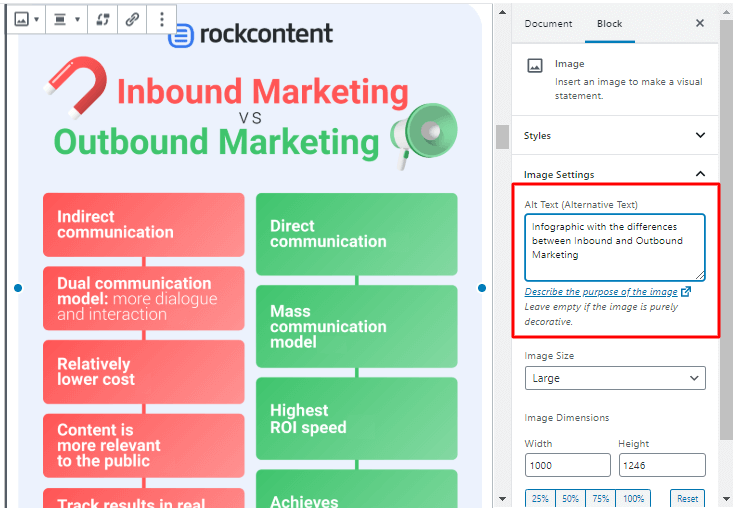
Through these elements, Google can understand what is in the image, index it correctly in Google Image Search, and it becomes another source of traffic.
Other aspects concerning image optimization for SEO include the size and format of image files so that they can be quickly loaded and indexed.
Internal links
The network of your site’s internal links also plays a role in on-page SEO.
The primary function of links between internal pages is to guide navigation and lead the user (and search engines) to other relevant content.
But they also have a technical SEO function. The network of internal links helps Google to find your content and better understand your site, as it reveals the hierarchy between pages.
For example, the closer to the homepage and the more internal links, the more important the page.
This link building strategy strengthens the authority of the blog through the links and this is how a topic cluster strategy works.
Rich Snippets
Rich snippets are content fragments from the page which provide additional information on the SERP. These can include site links, reviews, the number of comments, product prices, and more.
For example, here is the information provided through rich snippets when searching for “red velvet cupcake recipe”:

In this case, rich snippets provide us with a picture of the recipe, a review, comments, and even how long it will take to make.
Different from the usual results, right?
Rich snippets offer extra information about your pages to bots and users and highlight your link on SERPs, which tends to increase your click-through-rate (CTR).
To display rich snippets, they need to be created with structured data, as organized content is easier for the Googlebot to read.
This can be accomplished by programmers or even by using plugins, useful for WordPress sites.
Two sites can help you implement rich snippets.
The first is Google, which offers a list of rich snippets where you can identify the type you want to use, and they show you the code to use.
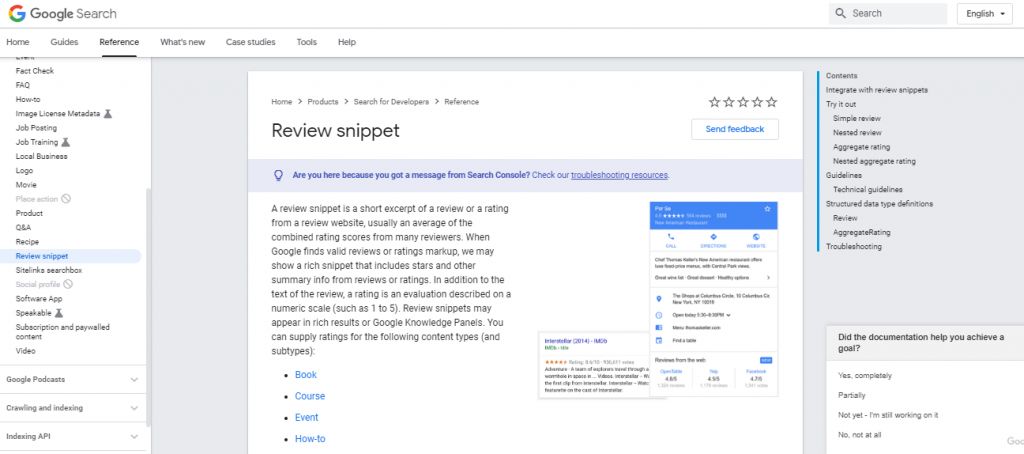
Access it at Google Developers.
The other site providing similar functionality is Schema.org. Here’s an example with a recipe snippet:
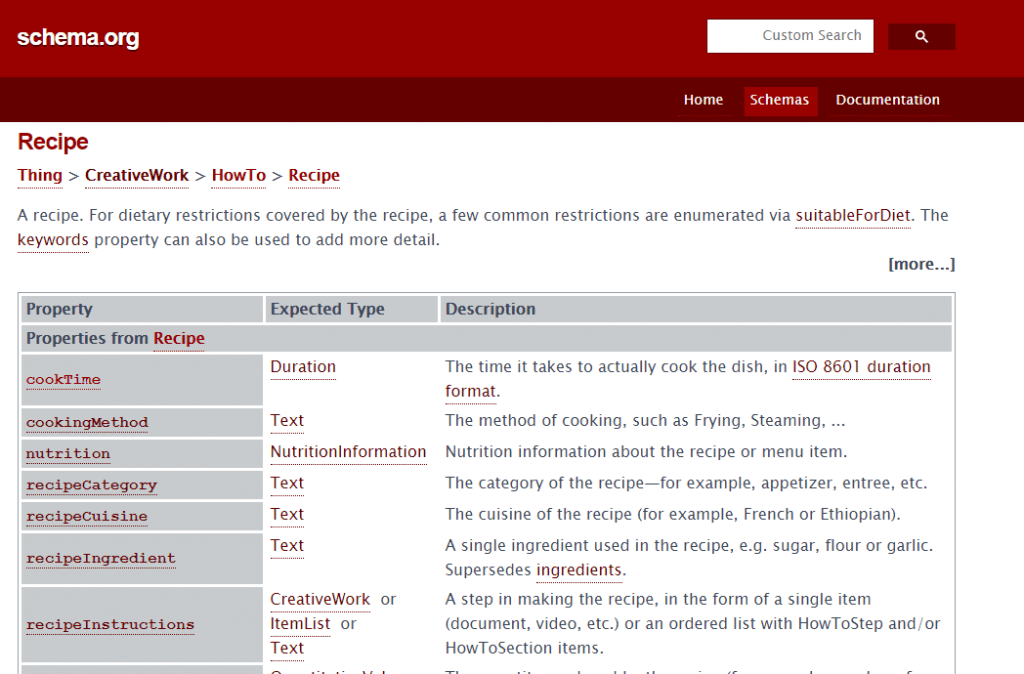
Featured Snippets
Have you noticed how Google provides ready answers on its SERP for some searches?
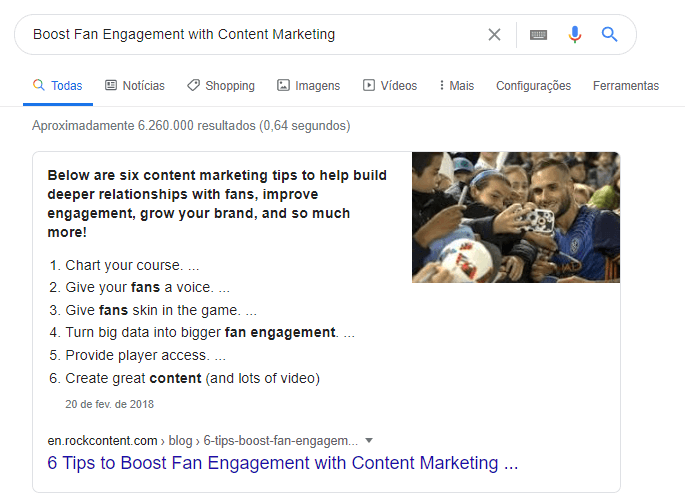
These are known as featured snippets and are excerpted highlights of pages that provide direct results in paragraphs, lists, or tables.
This is great for the user’s search experience! After all, they get the answer they’re looking for even faster.
But if fewer visitors reach your pages, what’s the impact on your traffic and results?
Keep calm. Featured snippets are a great opportunity to increase your authority on a specific topic and can lead to more traffic from the SERP, as the excerpts include a link to where they came from.
On-page SEO strategies need to be competitive to reach this “zero result” on Google.
EAT
This acronym has become the focus of SEO experts. EAT stands for Expertise, Authoritativeness, and Trustworthiness.
Google adopted these terms to orient its assessment of search result quality.
They were introduced in the documentation that guides the evaluators who manually analyze the relevance of search engine results.
They reveal what Google considers important when evaluating the quality of content.
- The expertise of the author.
- The authority of the author, the content and the site.
- The trustworthiness of the author, the content, and the site.
As a result, you can follow these guidelines in your content and SEO strategy to align with Google’s way of thinking.
What is Off-page SEO?
Now, it’s time to examine the factors beyond your pages with off-page SEO. What steps can you take to have more authority in the market and show Google that you are a reference?
Here you need to consider that, unlike on-page SEO, with off-page SEO you don’t have complete control over the optimization.
The choice to include backlinks to your site, mention or directly search for your brand depends on others.
What you can do is increase your chances of this happening. You can adopt link building, guest posting, redirects for broken links, in addition to other strategies to reinforce your backlink profile and create greater authority for your page.
Next, let’s learn some more about each of these strategies.
Link Building
Links are the building blocks of the internet. They connect one page to another and allow users to navigate and discover content.
Just like users, bots also travel this interconnected network to index new content and understand which pages are the most important, as one page transmits link juice and authority to another.
Here we can see why link building is so important to off-page SEO.
Link building is the construction of a network of links that point to your pages (known as backlinks) and strengthens your authority on the web.
Google’s algorithm understands that the more high-quality backlinks your page receives, the greater its relevance to the market.
But keep in mind that quantity and quality work together. There’s no benefit in receiving hundreds of backlinks if they all come from a single domain, or untrustworthy site, or are placed out of context.
To get a link building strategy to work, achieving high-quality backlinks is a must.
High-quality backlinks
As we’ve seen, Google acts to prevent actions that correspond to Black Hat.
Link building was previously used extensively to generate artificial authority, with schemes from link farms to the “super optimization” of anchor texts.
High-quality backlinks run contrary to these tactics and demonstrate that the links you have received are on merit and are relevant to trustworthy references in your sector.
High-quality backlinks:
- Are from sites with domain and page authority.
- Are from sites that Google trusts.
- Come from a variety of domains.
- Are natural in the context of the page.
- Use anchor text correctly.
- Are in a prominent position on the page (at the start of the piece, for example).
- Are from sites connected to your sector.
These are the main characteristics you should look for in backlinks when planning a link building strategy.
Nofollow Links
Another important point about backlinks: the difference between dofollow and nofollow links.
By default, all links are “dofollow”. This attribute tells bots that they should crawl the link and share authority from one page to the next.
In contrast, the “nofollow” attribute prevents the bot from following the link and passing authority to the linked page.
This can come in handy, for example, in comment sections or for links shared on social networks, which are frequently used for spam for building artificial authority.
But this doesn’t mean that nofollow links have no role to play in off-page SEO.
Even though they don’t spread authority directly to other pages, they generate traffic and develop brand awareness.
Link Building Techniques
Let’s take a look at which link building techniques you can employ to strengthen your authority.
Here are a few key ones!
Link Bait
Link bait is the most natural and efficient strategy.
It involves creating high-quality content that receives backlinks organically without requiring prospecting or partnerships.
To accomplish this, you should invest in creating rich content, share data from exclusive research, provide tools and resources as well as other forms of content that are worthwhile assets to link or share.
Guest posts
Guest posting involves publishing posts on partner blogs as a guest author.
It usually takes the form of trade: you create content for the other blog’s audience in exchange for one or more links to your site.
If the links employed are “dofollow”, this can attract new visitors and lead to a greater authority.
But it’s important to engage this strategy in moderation. If Google sees you receiving a large number of backlinks in a short period of time, it may understand this as black hat techniques and punish your pages.
Brand mentions
Brand mentions, even without linking to your site, are also valuable to SEO. Google analyzes these to recognize if your brand really exists and how well known it is.
You can also search for any unlinked mentions and identify opportunities to receive high-quality backlinks.
Simply get in touch with the administrator and politely suggest including a link.
Broken links
What happens when a site’s URL structure changes or content is removed? This can result in broken links across the site.
If you’ve ever clicked on a link and been brought to a 404 Error page, you’ve witnessed firsthand how broken links can result in lost opportunities and communicate less authority.
But if you come across links on sites with related content to your own, it’s a chance to recommend replacing those broken links with ones to your content.
Several tools exist to uncover broken links, such as Screaming Frog, Ahrefs, or Check My Links:
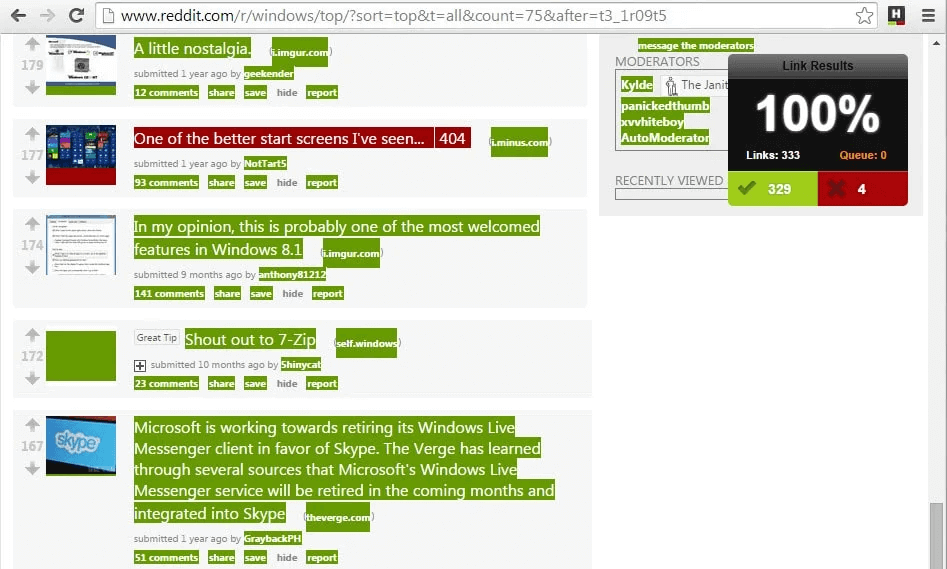
Link building tools
There are a variety of link building tools available, both free and paid, or with a focus on specific actions or specialization.
Tools including Majestic, Ahrefs, Moz Link Explorer, and SEMrush offer a complete analysis of a page’s backlinks profile, from the number of connections to the quality of the anchor text.
Some offer proprietary indicators to aid in this analysis, such as Majestic’s Trust Flow and Citation Flow or Domain Authority and Page Authority from Moz.
These tools are paid options but offer some resources for free.
Furthermore, you can work with more specific tools to focus on determining outcomes.
Examples include using Google Search Console to request Google reject backlinks from untrustworthy sites or Google Alert to notify you whenever your brand is mentioned to identify backlink opportunities.

Source: SEJ
How Does Technical SEO Work?
SEO is a vast universe that includes more technical aspects related to your site’s structure. Let’s take a look at these factors and how to optimize them!
Technical SEO is a key part of on-page SEO. It includes all of the optimizations you can make to the internal structure of a site — the code and underlying architecture — in an effort to make it faster and easier to understand, crawl, and index.
In the next topics, we’ve brought the main elements technical SEO can optimize.
Sitemap
A sitemap is a document that lays out the relationship between all of the pages on a site and information about them, such as when they were most recently updated or how often changes are made.
Its function within SEO is to provide this information to search engines to make it easier to find and index the URLs.
Although search engines already get this information through their bots, sitemaps simplify the process and ensure all pages get indexed.

You can either create a sitemap manually or through tools and plugins, then submit it via Google Search Console.
Robots.txt
Robots.txt is an additional document located in your site’s root folder, which lets Google know which pages on your site should be ignored and not appear in search results.
You can use robots.txt to prevent bots from accessing sensitive data, such as your admin login page (“/wp-admin/” on WordPress sites, for example), or scripts and stylesheets that aren’t important.
It’s important to remember robots.txt if your pages aren’t appearing in search engine results, as they may have been added to the list by accident.
UX (User Experience)
User Experience and SEO are two approaches that support each other. We’ve seen here that the priority for search engines is to offer the best search and navigation experience to users looking for something.
And this includes the experience on your site.
But what does user experience involve? It covers how sites are developed to focus on the actions and responses of users to address their needs.
According to Peter Morville, president of Semantic Studios, there are seven essential characteristics of good UX.
- Useful
- Usable
- Desirable
- Findable
- Accessible
- Valuable
- Credible
Page speed
How long a page takes to load is one of the main classification factors.
Google itself openly discussed that speed is a key ranking factor — for desktop search in 2010, and mobile search in 2018.
It should be mentioned that speed alone won’t get you to the top of the results, but you won’t get there without it.
A fast page speed won’t lift you above the competition, but a slow one will lower your ranking.
For Google, the quality of a user’s search experience depends on the agility of information, as people have become used to not having to wait for what they want to find.
This led to Google offering a free testing tool: PageSpeed Insights.
It provides a speed diagnosis report with tips on how to improve the load time through image and code optimizations.
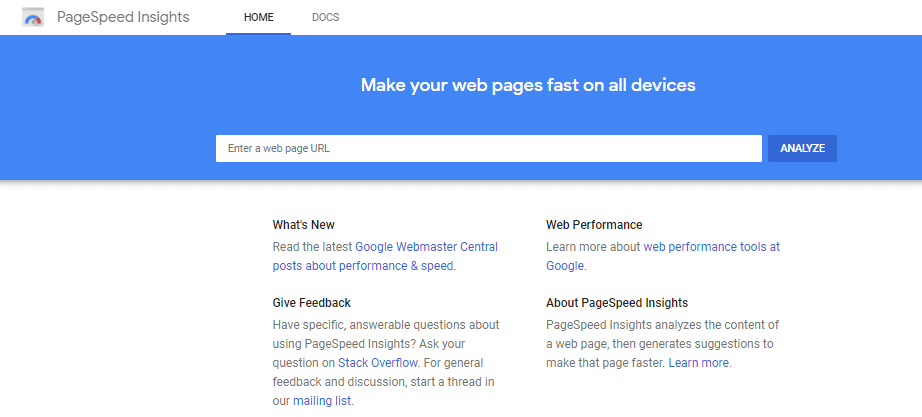
Mobile-First Index
Since cell phones are more common than computers, mobile search has overtaken desktop search.
With more traffic from mobile devices, Google began to prioritize results from sites that offer a strong mobile experience.
In 2015, Google announced that mobile-friendly had become a ranking factor for search on mobile devices, which resulted in many sites adopting responsive layouts.
A similar impact was brought about with the launch of the Mobile-First Index in 2016, which considered mobile versions of pages first when ranking.
So if you haven’t yet adopted these trends, it’s important to focus on improving usability and the experience of your content on users’ mobile devices.
Responsiveness
Implementing a responsive site design is one of the strongest recommendations for making your site mobile-friendly.
This technique allows your site to have one single version, which can then adapt to different screen sizes.
Besides a responsive layout, there are two other techniques you could consider adopting.
- Mobile URLs, with a different URL than the desktop version (for example, m.domain.com).
- Dynamic Serving, where the two versions have the same URL but use alternate CSS and HTML depending on the device.
To get a better understanding of how your site performs on mobile, you can check through Google’s mobile device compatibility test to get recommendations on optimizations you can make.
AMPs
Accelerated Mobile Pages is a further initiative to improve the mobile search experience.
It’s an open-source code project initially led by Google, which aims to develop static content pages that load faster on mobile devices.
These can be identified on mobile SERPs by the small lightning bolt icon next to the URL — and are given preference in the ranking. Take a look at the following example:

Source: AddThis
SEO Audits
An SEO audit is an important step to make sure you take as part of your technical SEO strategy, especially at the start of your optimization project.
It can be used to identify problems involving page speed, usability (especially more mobile), crawling, and other errors that affect users’ navigation and site ranking.
Here are a few of the elements that an audit can diagnose:
- Broken links
- Crawling errors
- Redirect errors
- Duplicate content
- Blocked pages (robots.txt, no-index, nofollow)
- Pages that are loading slowly
Screaming Frog is one of the best tools to solve these issues, offering in-depth reports on the topic listed above.
But an audit can also involve other tools, including SEMrush and Google Search Console.
[
What is Local SEO?
One of Google’s priorities in recent years has been understanding the intent behind local marketing.
Search engines understand that searches made at certain locations require contextual results, offering practical and objective information as opposed to the list of links traditional SERPs provide.
For these searches, Google created local search algorithms to prioritize results in the region the user is located or included in the search.
Similar to featured snippets, the search engine offers information from Google My Business directly in the search results in such a way that users don’t need to access the brand’s site.
Based on this, optimization for businesses with a physical location — known as local SEO — has a few specific details that require attention.
What does this mean for your optimization strategy? Find out below!
Local keywords
To display local results, Google attempts to understand the user’s local search intention.
In the case of searches for “pizzerias”, “pizza near me” or similar terms, Google takes into consideration the user’s location when the search was made and offers businesses in the area.
But if the user searches for “Boca Raton pizza”, the SERP will display results for the region in the search, regardless of the user’s location.
This is useful for individuals planning trips, for example.
So keyword research for a local SEO strategy should consider these variations of search intention, not simply those with your city.
Consider the following cases:
- Terms that identify a sector: e.g., pizzeria, pizza, neapolitan pizzeria
- Modifier terms: e.g., best pizza, cheap pizza
- Geographic modifiers: e.g., pizza in Boca Raton, pizzeria downtown, pizza near me
Google My Business
Google My Business is the main ranking factor for local SEO.
At the top of a local search SERP, Google displays the Local Pack, a box with three specific results for the user, based on information taken from Google My Business. And you should fight to make sure you show up there!
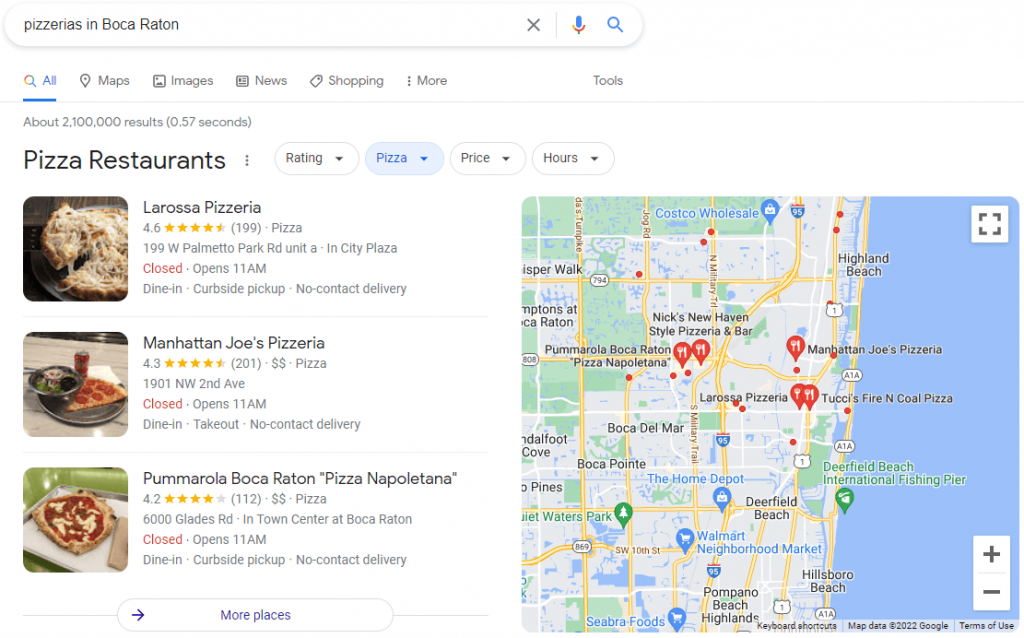
For your content to make it to the Local Pack, you need to register your company on Google My Business. This tool offers several resources for participating in local businesses.
You can submit your business name, address, phone number, and business hours. Then, you can receive ratings, answer users, upload photos, list your menu, and other specific details according to your business type.
Take advantage of the opportunities offered by registering and engaging your users to improve your chances of showing up in the Local Pack.
Google gives preference to businesses that have provided the most information, especially those with a high number of strong reviews.
Ranking factors
Google uses three key ranking factors for local search: relevance, proximity, and prominence.
The search engine reveals these criteria on its page, outlining recommendations for local ranking.
A combination of these factors is analyzed to provide the best results. For example, if a company is farther away from the user, but provides delivery, it may rank higher.
Let’s examine each of these factors in detail.
Relevance
Relevance includes the relationship between the search keyword and the product or service offered.
When searching for pizzas, the user doesn’t want to see Japanese restaurants, right?
This is why it’s so important to complete your Google My Business registration with all possible information since that’s how Google is able to make these connections.
If a user searches for “all-you-can-eat pizza”, Google will only return locations with that option.
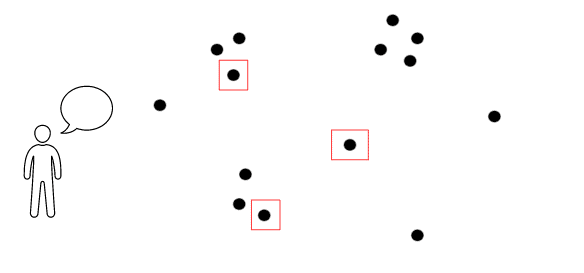
Proximity
Proximity refers to how far a business is from the user’s location or the location included in the search.
Google considers the closest results as better.
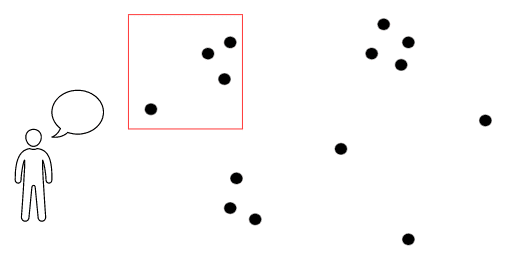
Prominence
Prominence assesses how popular the business is in a given region, based on online and offline factors.
If the business’s online presence isn’t so strong, but it’s a well-known and trusted brand offline, it can still achieve a good ranking
But it also strongly considers ratings and positive reviews from Google My Business users, plus the traditional on-page and off-page SEO used by the site.
The more trust Google gives to your business based on these elements, the higher your local ranking.
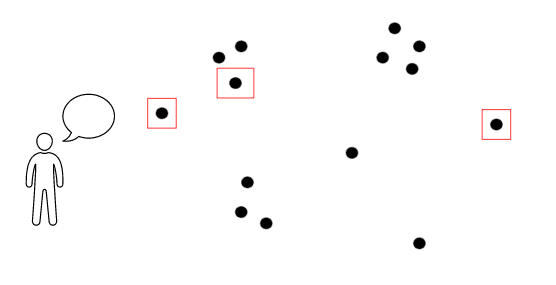
BONUS: How to Create the Best SEO Content
Content has always been the key to high search engine rankings and a growing, highly engaged audience.
But as search engines evolve and become increasingly efficient, the ability to produce SEO-friendly content becomes even more important.
Here’s how to get it right.
1. Adopt a straightforward writing style
A simple, clean writing style that helps a reader get straight to the point of your content is best for SEO. So are short sentences, frequent paragraph breaks, and an ability to stay on topic from start to finish.
2. Include quality links
One great way to keep content informative while remaining 100 percent on-topic is to add links to additional content that can be helpful.
Create internal links to additional on-site content that can answer further questions a reader may have. Use outbound links to third-party authority sites to confirm the validity of statistics or facts you may have included.
3. Pay attention to your metadata
The meta titles and meta descriptions attached to your content ultimately determine how it will appear to searchers on a SERP, so it’s crucial that it be accurate.
Make sure yours are concise but descriptive, and be sure to include your target keyword for even better optimization.
4. Use headings to organize your content
Both readers and search engines like content that’s organized and easy to skim. H1, H2, and H3 headings are very helpful in this regard.
To help with SEO, make sure your title and subheadings are clear and unambiguous.
Include keywords and key phrases in your headings where possible to help your content match user search intent.
5. Use multimedia to fortify your content
Including images, videos, graphics, and other types of rich content helps immensely when it comes to SEO, as they help break up your content and keep it interesting for readers.
However, keep in mind that search engines cannot “read” a video or an image, so add descriptive meta tags to multimedia content to help resolve this issue.
6. Know your SEO-friendly content types
Some content types are especially helpful for SEO, so any comprehensive content strategy makes good use of them.
Remember, search engines are in the business of serving human users, so Google “likes” the same types of content readers do.
- Long-form guides help visitors better understand in-depth topics.
- Lists, both numbered and otherwise, are engaging and reader-friendly.
- Videos address topics in a visually exciting way.
- How-to guides teach users how to do things using a simple step-by-step approach.
- Graphics, like videos, add visual interest and are appearing increasingly often in search results.
BONUS [2]: How to Use Social Media to Improve Your SEO
Like Google, social media has become a standard part of how digital-age people live their lives.
Yes, they use it to socialize and communicate with others. But they use it to obtain information and evaluate potential purchase decisions, too, so your SEO strategy really needs to include it.
1. Make your content shareable
The easier it is for a website visitor or social media user to share your content, the more likely they are to do that. Add assets like social media share buttons and clear calls-to-action (CTAs) to your content to encourage sharing whenever possible.
2. Fill your feeds with quality content
These days, it’s quality over quantity all the way when it comes to SEO, so keep that in mind when filling your blogs and social media streams with content.
Get to know your audience’s wants, needs, and crucial pain points. Then create top-shelf content to match.
Social media is especially helpful for getting more mileage out of your best material. Rework and refresh your content periodically before putting it back through your feeds to drive additional traffic.
3. Keep your profiles on-brand
Modern consumers typically scope a company out on social media before finalizing a purchase, so optimizing your profiles is crucial.
Make sure your tone, visual assets, and message are consistent across your social media, website, and any additional content you may post to platforms like Medium or Quora.
This helps ensure your audience can easily find you via Google.
4. Use social media to boost engagement
How much engagement your content attracts is a crucial factor in SEO.
Social media is terrific for raising overall engagement levels and showing Google that your brand is out there making waves.
So create posts that directly encourage followers to engage with you, both on social media and on your website. Share social media-friendly interactive content (like personality quizzes) to interest users in your brand. Use your feeds to start and participate in active conversations.
All of this helps support strong social media signals that, in turn, tell Google to assign high rankings to your site.
Wrap Up
So now that you’ve read our complete SEO guide, you’re ready to optimize your site and reach the top results on Google!
Our goal here has been to explain the main SEO concepts and the factors that will have the strongest influence on your SERP position.
If you want to take the next step, and leverage your strategy, take our SEO Maturity Assessment and identify where to focus efforts to evolve to the next stage on the maturity curve!